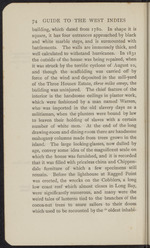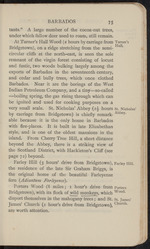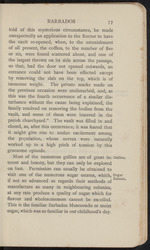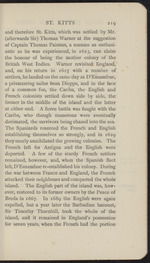|
|
|
Your search within this document for 'konsepto,number' resulted in 23 matching pages.
|
| 1 |
 |
“...PREFACE
Every year our beautiful and historic possessions
in the West Indies attract an increasing number
of visitors from England, who find in them a
pleasant refuge from the rigour and fogs of winter.
To our American cousins these colonies have
long been a profitable hunting-ground for health
and enjoyment. For some little time, however,
no attempt has been made to provide the tourist
with a guide which, while including within its
scope all the islands more igenerally visited, as
well as British Guiana and some of the foreign
islands, is still kept within such bounds as to
render it sufficiently condensed in form to permit
of its being carried in the pocket under a tropical
sun without inconvenience. Such a guide it is
the aim of the writer to provide. How far his
effort is successful, it must be left to the reader to
decide. If this small volume succeeds in inducing
a few to follow in the wake of Trollope, Froude
and Kingsley, who found so much happiness in a
voyage to the West; in ...”
|
|
| 2 |
 |
“...Puerto Cabello,
Curasao, Santa Marta and Cartagena; also to St.
Thomas, Puerto Colombia, Colon, and Kingston
(Jamaica). Fares: Barbados and Trinidad,
^17,10s.; Kingston, ^20; and St. Thomas, ^16
(including first-class railway fare from London to
Liverpool).
The Liverpool Line (Booker Bros., McConnell
and Co. Ltd., 77 The Albany, Liverpool). First-
class cargo steamers of this line sail from Liverpool
to Demerara (British Guiana) direct every three
weeks. They have accommodation for a limited
number of cabin passengers.
Compagnie Générale Transatlantique. The vessels
of this company leave St. Nazaire, France, on 9th
of each month and touch at the following ports :—
Dates. Dates.
Out. Home.
Arrive. Depart. Arrive. Depart, j
St. Nazaire 9 Colon 3
Pointe-è.-Pitre . 20 21 Cartagena . . 4 4
(Guadeloupe) Basseterre 21 21 Savanilla 5 5
(Guadeloupe) Fort-de-France 21 23 Puerto Cabello 7 7
(Martinique) Colon (touch- 29 St. Nazaire . 23
ing at various Pacific Ports on route)
An...”
|
|
| 3 |
 |
“...INDIES
The Azores, stormy. Four days out the Azores are passed, and j f
though they are not always visible, the Royal Mail
steamer occasionally stops to pick up coal on
the homeward journey. These Western Islands,
as they are also called, belong to Portugal, a
and are supposed to be the site of the ancient | il
Atlantis. They were discovered in the fifteenth o
century by Van der Berg, of Bruges, and by II
1457 the whole of the islands were discovered, p
and the name Azores given to them from the i
number of goshawks (Port. Afor) found on o
them. From 1580 to 1640 they were subject to t
Spain. The islands must always have a peculiar tl
interest for Englishmen as being the scene of the 1
memorable engagement between the Spanish and h
British fleets on August 30, 1591, when the r
redoubtable deeds of valour were performed by ii
Sir Richard Grenville, whose ship the Revenge 1
engaged eight great Spanish galleons for twelve 1
hours, and was boarded three times:— p
i i
“ And the sun went down, and...”
|
|
| 4 |
 |
“... who
are closely connected with the retail trade in the
colony.
With regard to the white population, the brief
histories of the various colonies which are given
on subsequent pages will sufficiently indicate their
origin. In the days of slavery each slave owner
was compelled to employ a certain number of
white servants to serve in the militia, and these
men helped to swell the population, while
Oliver Cromwell sent out many Irish prisoners,
I notably to Nevis and Montserrat; and Barbados
1 received a large influx of Royalists at the time
of the Commonwealth. Many English gentle-
men, Royalist officers and divines, were sent out
to the island and sold as slaves, and it is on
record that a number changed hands at a cost of
1500 lbs. of sugar per man! Their descendants,
known as “mean whites,” are still found there.
Even the ubiquitous Teuton is not omitted from
the list of those who have helped to populate
the islands, for in 1840 Mr. King imported twenty-
nine Germans into St. Lucia, while...”
|
|
| 5 |
 |
“...importance in order of the size of
their congregations. Presbyterians and Moravians
have a large following, while there are also
Roman Catholics and Jews in the island. In
Barbados the majority of the inhabitants belong
to the Church of England, which is endowed
from the general revenue. The island is the
see of a bishop, in which is included the Wind-
ward Islands also. Small Government grants
are given to the Wesleyans and Moravians, and
also to the Roman Catholics, who are, however,
few in number. The Leeward Islands also form
the see of a bishop of the Church of England,
whose principal followers are in Antigua and...”
|
|
| 6 |
 |
“...50 GUIDE TO THE WEST INDIES
' is strongly represented in the West Indies.
Much of this masonic spirit may be traced to
the military occupation of these islands; while
the register number of two lodges in Jamaica,
207 and 268, and one in Demerara, 246, under
the English constitution, show their antiquity.
Masonic visitors are, of course, welcomed at
these lodges in true masonic spirit.
Language. It may seem superfluous to add a paragraph
regarding language, but the writer is prompted
to do so by the many inquiries he has received
from intending visitors to the West Indies, who
seem to think that the islands are peopled by
savages speaking unknown tongues. On the
contrary, the inhabitants are mostly English-
speaking. The mode of speech attributed to
them in books, such as “massa” for “Master,”
&c., does not really adequately describe their
style, which owes its piquancy to the drawling
and sing-song method of delivery which is ac-
centuated to a marked degree in Barbados, where
even many...”
|
|
| 7 |
 |
“...BARBADOS
69
763 acres, three windmills with the necessary
building for the cultivation of sugar, 315 negroes,
and 100 head of cattle, to the Society for the
Propagation of the Gospel, in trust for the
maintenance of a convenient number of pro-
fessors and scholars, “ all of them to be under
the vows of poverty, chastity, and obedience;
who shall be obliged to study and practice
physic and chirurgery, as well as divinity;
that by the apparent usefulness of the former to
all mankind, they may both endear themselves to
the people and have the better opportunities of
doing good to men’s souls, whilst they are taking
care of their bodies.” At that time the planta-
tions were computed to yield a net income of
£2000 clear of all charges. The erection of the
college buildings was begun in 1716, and the
masonry was finished in 1721; but it was many
years before the college was completed, owing to
a debt due to the Society from the estates, which
was not cleared off until 1738. The stone used,
which...”
|
|
| 8 |
 |
“...repaired, when
it was struck by the terrific cyclone of August xo,
and though the scaffolding was carried off by
force of the wind and deposited in the mill-yard
of the Three Houses Estate, three miles away, the
building was uninjured. The chief feature of the
interior is the handsome ceilings in plaster work,
which were fashioned by a man named Warren,
who was imported in the old slavery days as a
militiaman, when the planters were bound by law
to leaven their holding of slaves with a certain
number of white men. At the end of the long
drawing-room and dining-room there are handsome
mahogany columns made from trees grown in the
island. The large looking-glasses, now dulled by
age, convey some idea of the magnificent scale on
which the house was furnished, and it is recorded
that it was filled with priceless china and Chippen-
dale furniture of which a few specimens still
remain. Before the lighthouse at Ragged Point
was erected, the wrecks on the Cobblers, a long
low coast reef which almost...”
|
|
| 9 |
 |
“...BARBADOS
75
tants.” A large number of the cocoa-nut trees,
under which fallow deer used to roam, still remain.
At Turner’s Hall Wood (2 hours by carriage from Turner’s
Bridgetown), on a ridge stretching from the semi- HaU-
circular cliffs at the north-east, is seen the sole
remnant of the virgin forest consisting of locust
and fustic, two woods bulking largely among the
exports of Barbados in the seventeenth century,
and cedar and bully trees, which once clothed
Barbados. Near it are the borings of the West
Indian Petroleum Company, and a tiny—so-called
—boiling spring, the gas rising through which can
be ignited and Used for cooking purposes on a
very small scale. St. Nicholas’ Abbey (2^ hours st. Nicholas'
by carriage from Bridgetown) is chiefly remark- Abbey'
able because it is the only house in Barbados
with fire-places. It is built in late Elizabethan
style, and is one of the oldest mansions in the
island. From Cherry Tree Hill, a short distance
beyond the Abbey, there is a striking...”
|
|
| 10 |
 |
“...BARBADOS
77
told of this mysterious circumstance, he made
unexpectedly an application to the Rector to have
the vault re-opened, when, to the astonishment
of all present, the coffins, to the number of five
or six, were found scattered about, and one of
the largest thrown on its side across the passage,
so that, had the door not opened outwards, an
entrance could not have been effected except
by removing the slab on the top, which is of
immense weight. The private marks made on
the previous occasion were undisturbed, and, as
this was the fourth occurrence of a similar dis-
turbance without the cause being explained, the
family resolved on removing the bodies from the
vault, and some of them were interred in the
parish churchyard.” The vault was filled in and
closed, as, after this occurrence, it was feared that
it might give rise to undue excitement among
the population, whose nerves were naturally
worked up to a high pitch of tension by this
gruesome episode.
Most of the numerous gullies...”
|
|
| 11 |
 |
“...were
only obtainable by chance variation. Now the
“ arrow ” or bloom of a full-sized cane is laid on
the top of a rich soil in a wooden tray, the soil
having been previously baked in order to kill all
weeds, and the fertilised seeds germinated in the
ordinary manner. When about an inch high, the
tiny grass-like shoots are transplanted into baskets
and eventually bedded out in the experimental cane
grounds adjoining. Throughout its whole career,
each cane selected for further test is known by a
number prefixed with a letter indicating the colony
of origin—thus D. stands for Demerara—so that
when a variety turns out favourably its history can...”
|
|
| 12 |
 |
“...958 acres; coffee, 27,765 acres; sugar-
canes, 26,838 acres; cocoa-nuts, 10,318 acres; cocoa,
6021 acres; ground provisions, pimento and guinea
grass are also extensively grown, the total area
under all kinds of cultivation being over 774,961
acres. Of the fruit exported, the principal kinds
are bananas, which amount to nearly 15,000,000
bunches per annum, the bulk going to the United
States of America. Oranges are next in import-
ance, the total exported annually being 75,000,000.
Cocoa-nuts number 7,000,000, and grape fruit,
shaddocks, limes, and kola-nuts are also shipped
in appreciable quantities. Jamaica is, of course,
famous for her rum, and on many estates in the
island the canes are grown primarily with the
object of rum manufacture. The coffee from the
Blue Mountains of Jamaica fetches the highest
price of any in the world; the ordinary estate...”
|
|
| 13 |
 |
“...JAMAICA 107
Officer, Colonial Secretary, Attorney - General,
Director of Public Works, and Collector-General,
and such other persons, not exceeding ten in
number, as His Majesty may from time to time
appoint, or as the Governor may from time to time
provisionally appoint, and fourteen persons elected
by the people. The Council is dissolved at the end
of five years from the last preceding general election,
if it has not been previously dissolved. There is
also a Privy Council, with the usual powers and
functions of an Executive Council. It consists
of the Lieutenant-Governor, if any; the Senior
Military Officer in command, the Colonial Secre-
tary, and Attorney-General, and such other per-
sons, not to exceed eight in number, as may be
named by the King, or provisionally appointed
by the Governor subject to the approval of His
Majesty. The Governor presides at each meet-
ing, and the Governor and two members form a
quorum.
Jamaica has many very good hotels, conducted Hotels,
on the American...”
|
|
| 14 |
 |
“...story, are placed, on gilt
brackets, the busts of several ancient and modern
philosophers and poets, large as life; which,
being in bronze, the darkness of their complexion
naturally suggests the idea of so many Negroe
Caboceros, exalted to this honourable distinction
for some peculiar services rendered to the country.
At the north end, over a door which opens into
the lobby, is a small movable orchestra, made to
hold a band of music on festive occasions. The
furniture below consists of a great number of
mahogany chairs and settees, sufficient to accom-
modate a large company; this room being chiefly
used for public audiences, entertainments, balls,
and the hearings of chancery and ordinary. At
the south end are three folding doors, opening
into a spacious apartment, in which, by the...”
|
|
| 15 |
 |
“... was appointed Governor.
The concession was confirmed by the Peace of
Amiens in 1802.
Trinidad, with which the neighbouring island, Constitu-
Tobago, is now incorporated, is a Crown Colony.
The government is administered by a Governor,
with an Executive Council of six members. There
is also a Legislative Council, consisting of ten
officials, and of such other unofficial members as
the Governor may appoint. These unofficial
members hold their seats for five years, and are
at present eleven in number.
Port of Spain. — The Queen's Park Hotel, Hotels,
situated on the south and breezy side 01 rne
Savannah, is quite one of the best in the West
Indies—R. L. A. 6s. 3d. and upwards, Pension
12s. 6d. per day. The Family Hotel, Marine
Square—R. L. A. 5s. per day, Pension 8s. 4d.
The Hotel de Paris, also in Marine Square—R. L....”
|
|
| 16 |
 |
“...148 QUIDE TO THE WEST INDIES
at the instance of Sir Nevile Lubbock, who was
also responsible for the development of cane
farming, a system by which peasant proprietors
grow sugar canes and deliver them when ripe to
the factory. The principle of the central factory
system in which the future of the West Indian
sugar industry is believed to lie, is the grouping
together of a number of estates whose sugar
canes are ground at one central base, with the
result that a considerable saving of expense is
effected. The canes are brought to the factory
by locomotives over railways, of which there
are some sixty miles running through or in
communication with the estates which feed this
particular Usine.
Princes Princes Town (8 miles by rail, and 7 by road
Town. from San Fernando) is chiefly worthy of notice
on account of the mud volcanoes some little
distance away, which, it must be admitted, are,
however, rather disappointing. Prior to a visit
of Prince Albert Victor and Prince George of
Wales, during...”
|
|
| 17 |
 |
“...on Satur-
Botanicai during market hours. The Botanical Gardens
ens.^x are onjy gye minutes distant by boat from St.
Government George’s. Government House stands on the hill-
side overlooking the town and harbour. The view
from the terrace is unsurpassed. On the Governor’s
reception day, visitors are always made welcome.
From Richmond Hill, a long ridge 800 feet high
(20 minutes by carnage from St. George’s), a
splendid view of the town and Carenage can be
obtained. The hill is studded with a number of
forts, and on it are situated several Government
institutions, including the lunatic and poor asylums,
which were formerly military barracks.
! A favourite excursion is that to the Grand Etang
• f (the Large Pond), a large circular freshwater lake
/w miles in circumference, 14 feet deep, and 1740
feet above the level of the sea (6f miles from St.
George’s). The road is good, and it is a pretty
drive through cocoa and provision grounds and
a wealth of tropical vegetation. The lake is be-
lieved...”
|
|
| 18 |
 |
“...the people on the
land, but nowhere have they proved so successful
as in Grenada. The leeward coast is very beautiful,
and recalls to mind the Italian Riviera. The land
breaks off abruptly in bluff headlands which, how-
ever, unlike those on many parts of the Italian
Sauteurs. coast, are densely covered with verdure. Sauteurs,
at the north of the island, is reached by coastal
steamer (see above) in 3 or 4 hours. It is of
interest as being the scene of the massacre of
Carib Indians, of whom a number, pursued by the
French under Le Compte, rushed up a narrow and
difficult path known to them alone, and threw
themselves over the edge of a cliff (Le Morne
des Sauteurs, or The Leapers’ Hill) overlooking
the bay, in 1650. The French, who only lost
one man, then set fire to the cottages and rooted
up the provisions of the Caribs, and, having de-
stroyed or taken away everything belonging to
them, returned, as Du Tertre naively describes
Cocoa and it, “ bien joyeux.” A visit to a cocoa and a
Estates...”
|
|
| 19 |
 |
“...182 GUIDE TO THE WEST INDIES
experimental plots. There is also a small Stock
Farm attached to it, where pedigree animals are
kept. The pupils of the school, about twenty-five
in number, receive a sound education in practical
agriculture and applied sciences free of cost to
their parents. Visitors can inspect this institu-
tion also on application to the resident master in
charge. Both the Cotton Ginnery and Agricultural
School are under the control of the Imperial
Department of Agriculture.
Soufrière. If time Permits> an expedition should be made
to the Soufrière, the volcano (3500 feet high)
situated at the northern end of the island, which
suddenly burst into violent eruption on 7th May
1902, a day in advance of La Montagne Pelée in
Martinique, after being quiescent since 1812, and
continued in a state of activity until March 1903.
The following account of the eruption, which re-
sulted in the loss of 2000 lives, was given by the
Rev. J. H. Darrell of Kingstown, who was an
eye-witness...”
|
|
| 20 |
 |
“...ST. KITTS
219
and therefore St. Kitts, which was settled by Mr.
(afterwards Sir) Thomas Warner at the suggestion
of Captain Thomas Painton, a seaman as enthusi-
astic as he was experienced, in 1623, can claim
the honour of being the mother colony of the
British West Indies. Warner revisited England,
and, on his return in 1625 with a number of
settlers, he landed on the same day as D’Esnambuc,
a privateering sailor from Dieppe, and in the face
of a common foe, the Caribs, the English and
French colonists settled down side by side, the
former in the middle of the island and the latter
at either end. A fierce battle was fought with the
Caribs, who though numerous were eventually
decimated, the survivors being chased into the sea.
The Spaniards resented the French and English
establishing themselves so strongly, and in 1629
they nearly annihilated the growing colonies. The
French left for Antigua and the English were
deported. A few of the sturdy French settlers
remained, however, and, when...”
|
|
|
